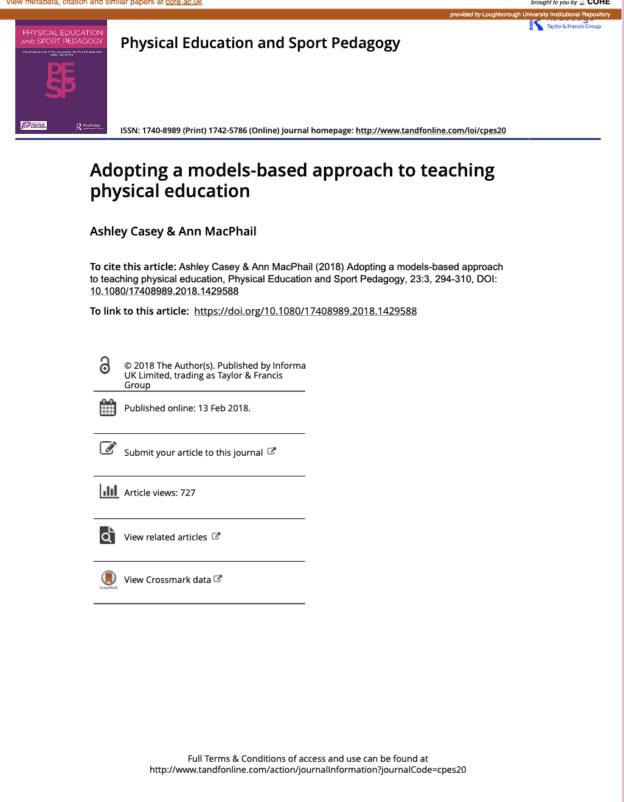Abstract
Background: The popularised notion of models-based practice (MBP) is one that focuses on the delivery of a model, e.g. Cooperative Learning, Sport Education, Teaching Personal and Social Responsibility, Teaching Games for Understanding. Indeed, while an abundance of research studies have examined the delivery of a single model and some have explored hybrid models, few have sought to meaningfully and
purposefully connect different models in a school’s curriculum (see Kirk, D. 2013. ‘Educational Value and Models-based Practice in Physical Education.’ Educational Philosophy and Theory 45 (9): 973–986.; Lund, J.,and D. Tannehill. 2015.
Standards-based Physical Education Curriculum Development. 3rd ed. Burlington, MA: Jones & Bartlett.; Quay, J., and J. Peters. 2008. ‘Skills, Strategies, Sport, and Social Responsibility: Reconnecting Physical Education.’ Journal of Curriculum Studies 40 (5): 601–626.). Significantly none, to date, have empirically investigated broader notions of MBP that make use of a range of different pedagogical models in/through the PE curriculum (Kirk, D. 2013. ‘Educational Value and Models-based Practice in Physical Education.’ Educational Philosophy and Theory 45 (9): 973–986.).
Aim: To provide a first empirical insight into using a MBP approach involving several models to teach physical education. At its heart, this paper presents the reader with the realistic and nuanced challenges that arise in striving towards, engaging with, planning for, and enacting a broader, multimodel notion of MBP.
Method: While the study itself was broader, we focus primarily on three units (one using Cooperative Learning, one using a Tactical Games/ Cooperative Learning hybrid and a third using Sport Education) taught to boys in two different age groups (i.e. 11–12 and 14–15). Two analytical questions inform and guide our enquiry: (1) What do we learn about MBP implementation through this project that would help other physical education practitioners implement a multimodel MBP approach? and (2) What are the key enablers and constraints of early MBP implementation? Data sources included (a) 21 semi-structured interviews with student groups, (b) teacher post-lesson and post-unit reflective analyses, (c) daily teacher reflective diaries, and (d) teacher unit diaries. Data were analysed comparatively considering the two analytical questions.
Results: The data analysis conveys strong themes around the areas of teacher and student prior learning, working toward facilitating a change in practice, sufficient time to consider changes in practice, and changing philosophies and practices. The results suggest that the consistent challenge that arose for the teacher towards the goal of adopting a MBP approach was the reduction of his overt involvement as a teacher. While the teacher bought into the philosophy of multimodel MBP he was continually frustrated at not progressing as quickly as he would like in changing his practice to match his philosophy.
Conclusions: Despite his best intentions, early attempts to use a multimodel MBP approach were limited by the teacher’s ability to reconceptualise teaching. The teacher made ‘rookie mistakes’ and tried to
transfer his normal classroom practice onto paper handouts while simultaneously inviting students to play a more central role in the classroom. In considering this journey, we can see an indication of the
investment needed to implement a MBP approach. Pedagogical change in the form of MBP is a process that needs to be supported by a community of practice intent on improving learning across multiple
domains in physical education.



Responses